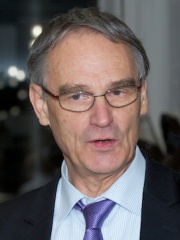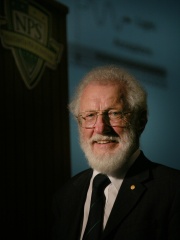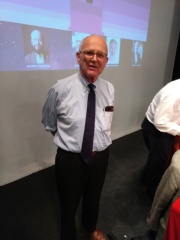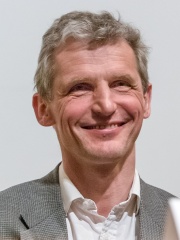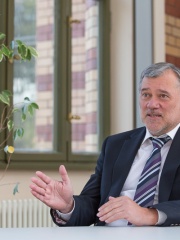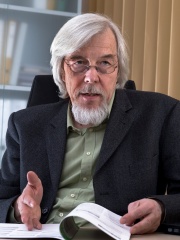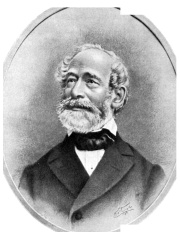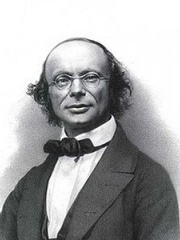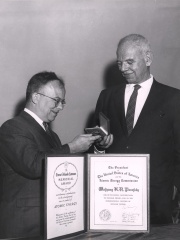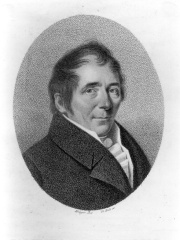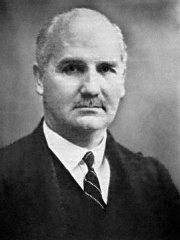
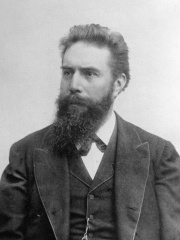
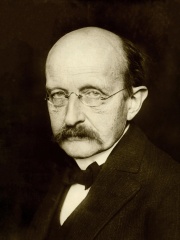
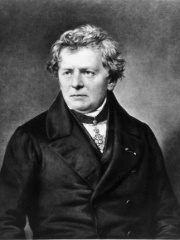
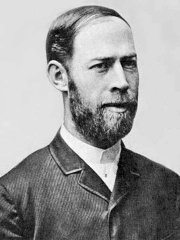
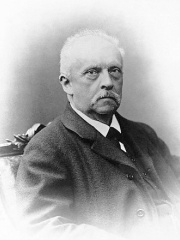
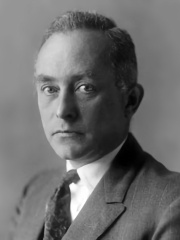

The Most Famous
PHYSICISTS from Germany
This page contains a list of the greatest German Physicists. The pantheon dataset contains 717 Physicists, 97 of which were born in Germany. This makes Germany the birth place of the 2nd most number of Physicists.
Top 10
The following people are considered by Pantheon to be the top 10 most legendary German Physicists of all time. This list of famous German Physicists is sorted by HPI (Historical Popularity Index), a metric that aggregates information on a biography’s online popularity. Visit the rankings page to view the entire list of German Physicists.

1. Albert Einstein (1879 - 1955)
With an HPI of 93.06, Albert Einstein is the most famous German Physicist. His biography has been translated into 214 different languages on wikipedia.
Albert Einstein ( EYEN-styne; German: [ˈalbɛɐt ˈʔaɪnʃtaɪn] ; 14 March 1879 – 18 April 1955) was a German-born theoretical physicist who is widely held to be one of the greatest and most influential scientists of all time. Best known for developing the theory of relativity, Einstein also made important contributions to quantum mechanics, and was thus a central figure in the revolutionary reshaping of the scientific understanding of nature that modern physics accomplished in the first decades of the twentieth century. His mass–energy equivalence formula E = mc2, which arises from relativity theory, has been called "the world's most famous equation". He received the 1921 Nobel Prize in Physics "for his services to theoretical physics, and especially for his discovery of the law of the photoelectric effect", a pivotal step in the development of quantum theory. His work is also known for its influence on the philosophy of science. In a 1999 poll of 130 leading physicists worldwide by the British journal Physics World, Einstein was ranked the greatest physicist of all time. His intellectual achievements and originality have made the word Einstein broadly synonymous with genius. Born in the German Empire, Einstein moved to Switzerland in 1895, forsaking his German citizenship (as a subject of the Kingdom of Württemberg) the following year. In 1897, at the age of seventeen, he enrolled in the mathematics and physics teaching diploma program at the Swiss federal polytechnic school in Zürich, graduating in 1900. In 1901, he acquired Swiss citizenship, which he kept for the rest of his life. In 1903, he secured a permanent position at the Swiss Patent Office in Bern. In 1905, he submitted a successful PhD dissertation to the University of Zurich. In 1914, he moved to Berlin in order to join the Prussian Academy of Sciences and the Humboldt University of Berlin. In 1917, he became director of the Kaiser Wilhelm Institute for Physics; he also became a German citizen again, this time as a subject of the Kingdom of Prussia. In 1933, while he was visiting the United States, Adolf Hitler came to power in Germany. Horrified by the Nazi "war of extermination" against his fellow Jews, Einstein decided to remain in the US, and was granted American citizenship in 1940. On the eve of World War II, he endorsed a letter to President Franklin D. Roosevelt alerting him to the potential German nuclear weapons program and recommending that the US begin similar research. Einstein supported the Allies but generally viewed the idea of nuclear weapons with great dismay. In 1905, sometimes described as his annus mirabilis (miracle year), Einstein published four groundbreaking papers. These outlined a theory of the photoelectric effect, explained Brownian motion, introduced his special theory of relativity—a theory which addressed the inability of classical mechanics to account satisfactorily for the behavior of the electromagnetic field—and demonstrated that if the special theory is correct, mass and energy are equivalent to each other. In 1915, he proposed a general theory of relativity that extended his system of mechanics to incorporate gravitation. A cosmological paper that he published the following year laid out the implications of general relativity for the modeling of the structure and evolution of the universe as a whole. The middle part of his career also saw him making important contributions to statistical mechanics and quantum theory. Especially notable was his work on the quantum physics of radiation, in which light consists of particles, subsequently called photons. For much of the last phase of his academic life, Einstein worked on two endeavors that proved ultimately unsuccessful. Firstly, he advocated against quantum theory's introduction of fundamental randomness into science's picture of the world, objecting that "God does not play dice". Secondly, he attempted to devise a unified field theory by generalizing his geometric theory of gravitation to include electromagnetism too. As a result, he became increasingly isolated from the mainstream of modern physics.

2. Wilhelm Röntgen (1845 - 1923)
With an HPI of 83.44, Wilhelm Röntgen is the 2nd most famous German Physicist. His biography has been translated into 132 different languages.
Wilhelm Conrad Röntgen (; German pronunciation: [ˈvɪlhɛlm ˈʁœntɡən] ; 27 March 1845 – 10 February 1923) was a German mechanical engineer and physicist, who, on 8 November 1895, produced and detected electromagnetic radiation in a wavelength range known as X-rays or Röntgen rays, an achievement that earned him the inaugural Nobel Prize in Physics in 1901. In honour of Röntgen's accomplishments, in 2004 the International Union of Pure and Applied Chemistry (IUPAC) named element 111, roentgenium, a radioactive element with multiple unstable isotopes, after him. The unit of measurement roentgen was also named after him.

3. Max Planck (1858 - 1947)
With an HPI of 81.76, Max Planck is the 3rd most famous German Physicist. His biography has been translated into 135 different languages.
Max Karl Ernst Ludwig Planck (English: , German: [maks ˈplaŋk] ; 23 April 1858 – 4 October 1947) was a German theoretical physicist whose discovery of energy quanta won him the Nobel Prize in Physics in 1918. Planck made many substantial contributions to theoretical physics, but his fame as a physicist rests primarily on his role as the originator of quantum theory, which revolutionized understanding of atomic and subatomic processes. He is known for Planck's constant, which is of foundational importance for quantum physics, and which he used to derive a set of units, today called Planck units, expressed only in terms of fundamental physical constants. Planck was twice president of the German scientific institution Kaiser Wilhelm Society. In 1948, it was renamed the Max Planck Society (Max-Planck-Gesellschaft) and nowadays includes 83 institutions representing a wide range of scientific directions.

4. Georg Ohm (1789 - 1854)
With an HPI of 79.15, Georg Ohm is the 4th most famous German Physicist. His biography has been translated into 91 different languages.
Georg Simon Ohm (, German: [ˈɡeːɔʁk ˈʔoːm]; 16 March 1789 – 6 July 1854) was a German physicist and mathematician. As a school teacher, Ohm began his research with the new electrochemical cell, invented by Italian scientist Alessandro Volta. Using equipment of his own creation, Ohm found that there is a direct proportionality between the potential difference (voltage) applied across a conductor and the resultant electric current. This relation is called Ohm's law, and the ohm, the unit of electrical resistance, is named after him.
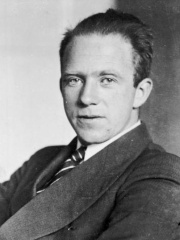
5. Werner Heisenberg (1901 - 1976)
With an HPI of 78.94, Werner Heisenberg is the 5th most famous German Physicist. His biography has been translated into 107 different languages.
Werner Karl Heisenberg (pronounced [ˈvɛʁnɐ kaʁl ˈhaɪzn̩bɛʁk] ; 5 December 1901 – 1 February 1976) was a German theoretical physicist, one of the main pioneers of the theory of quantum mechanics, and a principal scientist in the Nazi nuclear weapons program during World War II. He published his Umdeutung paper in 1925, a major reinterpretation of old quantum theory. In the subsequent series of papers with Max Born and Pascual Jordan, during the same year, his matrix formulation of quantum mechanics was substantially elaborated. He is known for the uncertainty principle, which he published in 1927. Heisenberg was awarded the 1932 Nobel Prize in Physics "for the creation of quantum mechanics". Heisenberg also made contributions to the theories of the hydrodynamics of turbulent flows, the atomic nucleus, ferromagnetism, cosmic rays, and subatomic particles. He was also instrumental in planning the first West German nuclear reactor at Karlsruhe, together with a research reactor in Munich, in 1957. Following World War II, he was appointed director of the Kaiser Wilhelm Institute for Physics, which soon thereafter was renamed the Max Planck Institute for Physics. He was director of the institute until it was moved to Munich in 1958. He then became director of the Max Planck Institute for Physics and Astrophysics from 1960 to 1970. Heisenberg was also president of the German Research Council, chairman of the Commission for Atomic Physics, chairman of the Nuclear Physics Working Group, and president of the Alexander von Humboldt Foundation.

6. Heinrich Hertz (1857 - 1894)
With an HPI of 77.14, Heinrich Hertz is the 6th most famous German Physicist. His biography has been translated into 93 different languages.
Heinrich Rudolf Hertz ( HURTS; German: [ˈhaɪnʁɪç ˈhɛʁts]; 22 February 1857 – 1 January 1894) was a German physicist who first conclusively proved the existence of the electromagnetic waves predicted by James Clerk Maxwell's equations of electromagnetism. The unit of frequency, cycle per second, was named the "hertz" in his honor.

7. Hermann von Helmholtz (1821 - 1894)
With an HPI of 72.07, Hermann von Helmholtz is the 7th most famous German Physicist. His biography has been translated into 68 different languages.
Hermann Ludwig Ferdinand von Helmholtz (31 August 1821 – 8 September 1894) was a German physicist and physician who made significant contributions in several scientific fields, particularly hydrodynamic stability. The Helmholtz Association, the largest German association of research institutions, is named in his honour. In the fields of physiology and psychology, Helmholtz is known for his mathematics concerning the eye, theories of vision, ideas on the visual perception of space, colour vision research, the sensation of tone, perceptions of sound, and empiricism in the physiology of perception. In physics, he is known for his theories on the conservation of energy and on the electrical double layer, work in electrodynamics, chemical thermodynamics, and on a mechanical foundation of thermodynamics. As a philosopher, he is known for his philosophy of science, ideas on the relation between the laws of perception and the laws of nature, the science of aesthetics, and ideas on the civilizing power of science.

8. Max Born (1882 - 1970)
With an HPI of 71.56, Max Born is the 8th most famous German Physicist. His biography has been translated into 91 different languages.
Max Born (German pronunciation: [ˈmaks ˈbɔʁn] ; 11 December 1882 – 5 January 1970) was a German-British physicist and mathematician who was instrumental in the development of quantum mechanics. He also made contributions to solid-state physics and optics and supervised the work of a number of notable physicists in the 1920s and 1930s. Born was awarded the 1954 Nobel Prize in Physics for his "fundamental research in quantum mechanics, especially in the statistical interpretation of the wave function". Born entered the University of Göttingen in 1904, where he met the three renowned mathematicians Felix Klein, David Hilbert, and Hermann Minkowski. He wrote his PhD thesis on the subject of "Stability of Elastica in a Plane and Space", winning the university's Philosophy Faculty Prize. In 1905, he began researching special relativity with Minkowski, and subsequently wrote his habilitation thesis on the Thomson model of the atom. A chance meeting with Fritz Haber in Berlin in 1918 led to discussion of how an ionic compound is formed when a metal reacts with a halogen, which is today known as the Born–Haber cycle. In World War I he was originally placed as a radio operator, but his specialist knowledge led to his being moved to research duties on sound ranging. In 1921 Born returned to Göttingen, where he arranged another chair for his long-time friend and colleague James Franck. Under Born, Göttingen became one of the world's foremost centres for physics. In 1925 Born and Werner Heisenberg formulated the matrix mechanics representation of quantum mechanics. The following year, he formulated the now-standard interpretation of the probability density function for ψ*ψ in the Schrödinger equation, for which he was awarded the Nobel Prize in 1954. His influence extended far beyond his own research. Max Delbrück, Siegfried Flügge, Friedrich Hund, Pascual Jordan, Maria Goeppert-Mayer, Lothar Wolfgang Nordheim, Robert Oppenheimer, and Victor Weisskopf all received their PhD degrees under Born at Göttingen, and his assistants included Enrico Fermi, Werner Heisenberg, Gerhard Herzberg, Friedrich Hund, Wolfgang Pauli, Léon Rosenfeld, Edward Teller, and Eugene Wigner. In January 1933, the Nazi Party came to power in Germany, and Born, who was Jewish, was suspended from his professorship at the University of Göttingen. He emigrated to the United Kingdom, where he took a job at St John's College, Cambridge, and wrote a popular science book, The Restless Universe, as well as Atomic Physics, which soon became a standard textbook. In October 1936, he became the Tait Professor of Natural Philosophy at the University of Edinburgh, where, working with German-born assistants E. Walter Kellermann and Klaus Fuchs, he continued his research into physics. Born became a naturalised British subject on 31 August 1939, one day before World War II broke out in Europe. He remained in Edinburgh until 1952. He retired to Bad Pyrmont, in West Germany, and died in a hospital in Göttingen on 5 January 1970.

9. Otto von Guericke (1602 - 1686)
With an HPI of 71.08, Otto von Guericke is the 9th most famous German Physicist. His biography has been translated into 57 different languages.
Otto von Guericke (UK: GAIR-ik-ə, US: G(W)AIR-ik-ə, -ee, German: [ˈɔtoː fɔn ˈɡeːʁɪkə] ; spelled Gericke until 1666; 30 November [O.S. 20 November] 1602 – 21 May [O.S. 11 May] 1686) was a German scientist, inventor, mathematician and physicist. His pioneering scientific work, the development of experimental methods and repeatable demonstrations on the physics of the vacuum, atmospheric pressure, electrostatic repulsion, his advocacy for the reality of "action at a distance" and of "absolute space" were noteworthy contributions for the advancement of the Scientific Revolution. Von Guericke was a very pious man in the Dionysian tradition and attributed the vacuum of space to the creations and designs of an infinite divinity. Von Guericke described this duality "as something that 'contains all things' and is 'more precious than gold, without beginning and end, more joyous than the perception of bountiful light' and 'comparable to the heavens'."
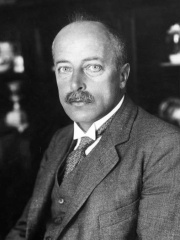
10. Max von Laue (1879 - 1960)
With an HPI of 69.58, Max von Laue is the 10th most famous German Physicist. His biography has been translated into 78 different languages.
Max Theodor Felix von Laue (German: [maks fɔn ˈlaʊ̯ə] ; 9 October 1879 – 24 April 1960) was a German physicist who received the Nobel Prize in Physics in 1914 for his discovery of the diffraction of X-rays by crystals. In addition to his scientific endeavors with contributions in optics, crystallography, quantum theory, superconductivity, and the theory of relativity, Laue had a number of administrative positions which advanced and guided German scientific research and development during four decades. A strong objector to Nazism, he was instrumental in re-establishing and organizing German science after World War II.
Pantheon has 97 people classified as physicists born between 1575 and 1957. Of these 97, 10 (10.31%) of them are still alive today. The most famous living physicists include Gerd Binnig, Herbert Kroemer, and Klaus Hasselmann. The most famous deceased physicists include Albert Einstein, Wilhelm Röntgen, and Max Planck. As of April 2022, 8 new physicists have been added to Pantheon including Klaus Hasselmann, Theodor W. Hänsch, and Johanna Budwig.
Living Physicists
Go to all Rankings
Gerd Binnig
1947 - Present
HPI: 63.26
Herbert Kroemer
1928 - Present
HPI: 62.41
Klaus Hasselmann
1931 - Present
HPI: 61.23
Georg Bednorz
1950 - Present
HPI: 61.03
Theodor W. Hänsch
1941 - Present
HPI: 60.88
Rainer Weiss
1932 - Present
HPI: 60.45
Horst Ludwig Störmer
1949 - Present
HPI: 58.43
Wolfgang Ketterle
1957 - Present
HPI: 55.03
Jürgen Kurths
1953 - Present
HPI: 43.02
Rolf-Dieter Heuer
1948 - Present
HPI: 42.68

Deceased Physicists
Go to all Rankings
Albert Einstein
1879 - 1955
HPI: 93.06
Wilhelm Röntgen
1845 - 1923
HPI: 83.44
Max Planck
1858 - 1947
HPI: 81.76
Georg Ohm
1789 - 1854
HPI: 79.15
Werner Heisenberg
1901 - 1976
HPI: 78.94
Heinrich Hertz
1857 - 1894
HPI: 77.14
Hermann von Helmholtz
1821 - 1894
HPI: 72.07
Max Born
1882 - 1970
HPI: 71.56
Otto von Guericke
1602 - 1686
HPI: 71.08
Max von Laue
1879 - 1960
HPI: 69.58
Carl Zeiss
1816 - 1888
HPI: 69.50
Wilhelm Eduard Weber
1804 - 1891
HPI: 69.24

Newly Added Physicists (2022)
Go to all Rankings
Klaus Hasselmann
1931 - Present
HPI: 61.23
Theodor W. Hänsch
1941 - Present
HPI: 60.88
Johanna Budwig
1908 - 2003
HPI: 55.39
Burkhard Heim
1925 - 2001
HPI: 48.37
Pief Panofsky
1919 - 2007
HPI: 44.69
Ernst Ising
1900 - 1998
HPI: 44.19
Ludwig Wilhelm Gilbert
1769 - 1824
HPI: 42.92
Frederick Lindemann, 1st Viscount Cherwell
1886 - 1957
HPI: 38.79

Which Physicists were alive at the same time? This visualization shows the lifespans of the 25 most globally memorable Physicists since 1700.

